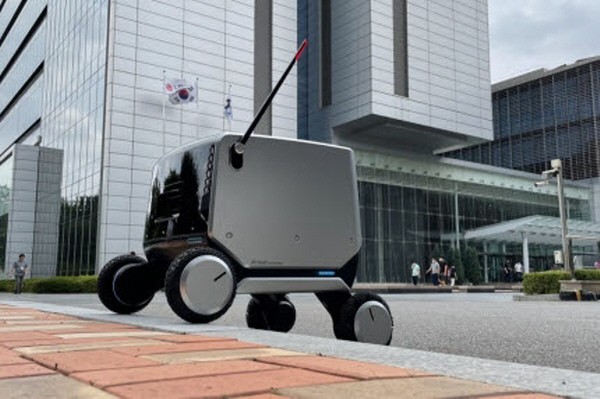Cannot operate outside the building or in outdoor parks other than indoors.
Camera based… to be an obstacle in the Personal Information Protection Act
Expected to account for 20% of total delivery vo

Self-driving delivery robots are developing one after another, but there is still a long way to go before full-scale commercialization due to various outdated regulations. Technology development is slowing down, as it is illegal for a robot to leave a building and it is difficult to obtain related data. The industry has pointed out the need for preemptive regulatory reform in line with the era of 'self-driving' robots.
According to related industries on the 14th, startups such as Baemin, Neubility, and Robotis, as well as large companies such as LG Electronics, KT, and SKT are spurring the commercialization of self- delivery robots. Most of them are aiming for commercialization as early as next year after pilot operation this year. Robots that serve limited indoor spaces such as restaurants and airports are already coming out.
The market prospect is also bright. According to market research firm Lux Research, delivery robots will account for 20% of the total delivery volume and the market size is expected to reach 50 trillion wonby 2030. With the rapid growth of non-face-to-face e-commerce due to COVID-19 in particular, the commercialization of self-driving logistics robots is accelerating worldwide.
Although the self-driving market is expected to open early, Korea is still facing a 'regulatory minefield'. First, according to the Road Traffic Act, it is illegal for robots to come to outside from indoors. Although delivery robots collect data based on cameras, camera-based autonomous driving is currently illegal in Korea due to the Personal Information Protection Act. Robots also cannot move to an outdoor park because autonomous driving is not allowed under the Parks and Greenery Act. For example, one must cross Yeouido Park to go from east to west of Yeouido.
However, autonomous delivery robots cannot enter the park. According to the Living Logistics Act, only motorcycles and automobiles can deliver goods, and only people can carry out logistics transport. Delivery via robots is subject to regulation.
Relevant companies are striving to first get an opportunity to test even in a specific region through a regulatory sandbox. Prior to this, Baemin received approval for the special demonstration case of the ICT regulatory sandbox and piloted the outdoor autonomous driving delivery robot 'Delivery Drive' at Gwanggyo Alleyway in Suwon-si, Gyeonggi-do.
The company official said, “First, we are trying to get a test opportunity through the regulatory sandbox. But this is also possible only in very small areas, thuslimiting technology development or business expansion.”
Another company official said, “Autonomous driving is actually a data battle of who goes to a difficult environment by how much. Although datasets in extreme situations are absolutely needed to improve autonomous driving performance, it is practically meaningless to accumulate data only in quiet, slow new towns or regulatory sandbox zones where this is rarely the case.
The United States and Japan are speeding up the preparation of a legal basis for delivery robots. Japan plans to amend the Road Traffic Act within this year to allow delivery robots to navigate the streets.
However, Korea still lacks institutional discussion on delivery robots. It plans to improve the system in line with the speed of technology development and market trends in the future.
An official from the Ministry of Land, Infrastructure, and Transport said, “The enactment of Living Logistics Act could not include various transportation methods such as robots and drones due to opposition from the cargo industry.We plan to incorporate them into the system and manage them to grow related markets.”
By Staff Reporter Hyeon-heeSeongsunghh@etnews.com